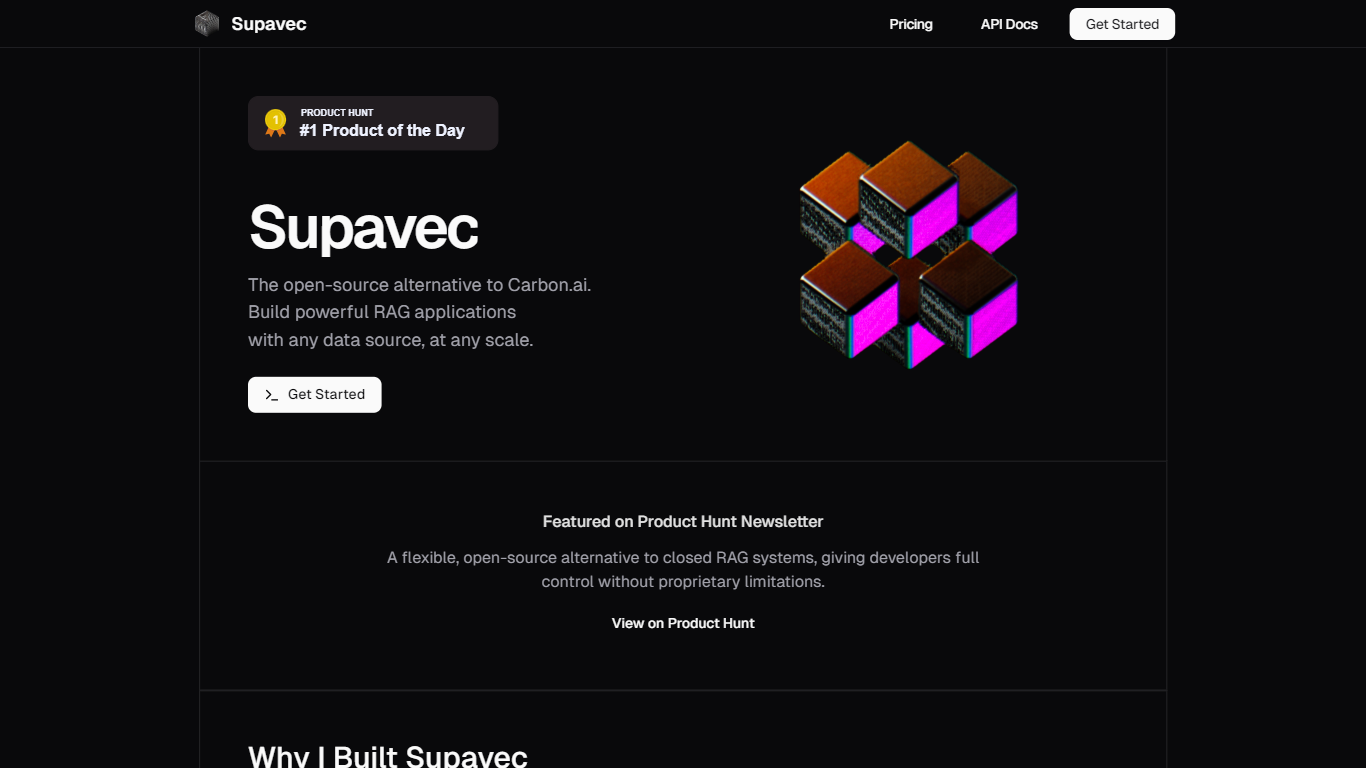Supavec
Supavec is an open-source platform that enables developers to build Retrieval-Augmented Generation (RAG) applications by integrating any data source with large language models. It enhances AI responses by retrieving precise, context-aware information from user documents, rather than relying solely on general AI knowledge. This approach improves accuracy and relevance in AI-powered applications.
The platform targets developers, sales agencies, support teams, and businesses that need scalable, secure, and customizable RAG solutions. It supports use cases like sales call analysis, support knowledge bases, internal policy queries, and developer documentation search, making it versatile across industries.
Supavec offers full transparency and control by being fully open source under the MIT license and built on Supabase with row-level security to protect data privacy. Users can self-host on their own infrastructure or use Supavec's cloud service, avoiding vendor lock-in and ensuring compliance with enterprise security requirements.
The platform supports fast ingestion of documents, transcripts, and tickets via REST APIs or SDKs, transforming them into searchable vectors. It handles millions of documents and concurrent queries efficiently, with sub-300ms response times for search results. Supavec also features advanced speaker diarization and context-aware chunking for accurate processing of multi-speaker transcripts.
A standout feature is its AI-powered sales call coaching tool that automatically generates actionable coaching briefs from call transcripts, surfacing wins, objections, next steps, and sentiment insights. This helps sales teams improve performance without extra manual effort.
Supavec integrates smoothly with existing tools like Zoom, Fireflies, Gong, HubSpot, Salesforce, and Microsoft Teams, fitting into current workflows without requiring platform migration. Its REST API and open-source nature allow for custom integrations and modifications tailored to specific needs.
Overall, Supavec is a flexible, scalable, and privacy-focused RAG platform that empowers developers and businesses to build AI applications leveraging their own data with full control and transparency.
🔑 Easy API key generation for secure access
📄 Fast document ingestion via REST API or SDKs
📞 AI-powered sales call coaching with actionable insights
🔍 Sub-300ms semantic search with context-aware retrieval
🔒 Enterprise-grade data privacy with Supabase RLS
Open-source with MIT license for full customization
Supports self-hosting and cloud deployment options
Enterprise-grade security with row-level data protection
Fast, scalable processing of millions of documents
AI-powered sales call coaching automates insights
Currently optimized mainly for English language
Advanced features may require paid plans
How does Supavec ensure data privacy?
Supavec uses Supabase row-level security to keep your data private and secure, allowing you to self-host or use their cloud with enterprise-grade protections.
Can I integrate Supavec with my existing CRM or support tools?
Yes, Supavec supports integrations with platforms like Zendesk, Notion, Confluence, HubSpot, Salesforce, and Microsoft Teams through APIs and custom connectors.
What file formats does Supavec support for sales call transcripts?
Supavec supports common transcript formats including .vtt and .srt files, as well as integrations with Fireflies, Zoom, Gong, and Teams.
Is it possible to customize the AI coaching templates?
Yes, you can create and modify coaching frameworks and insight categories to fit your agency’s specific criteria and share templates across teams.
How fast does Supavec process and return search results?
Supavec delivers semantic search results in under 300 milliseconds, even with large document repositories.
Does Supavec support multiple languages?
Currently, Supavec is optimized for English, with beta support for Spanish, French, and German, and plans to expand language coverage.
Can I switch between pricing plans easily?
Yes, you can upgrade or downgrade your plan anytime with prorated billing for upgrades and changes effective next billing cycle for downgrades.

